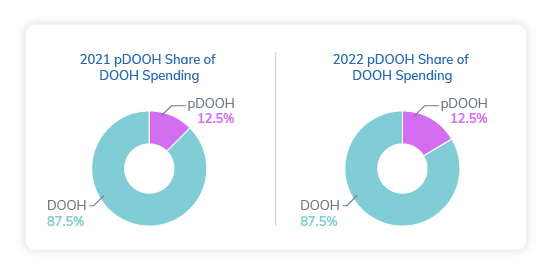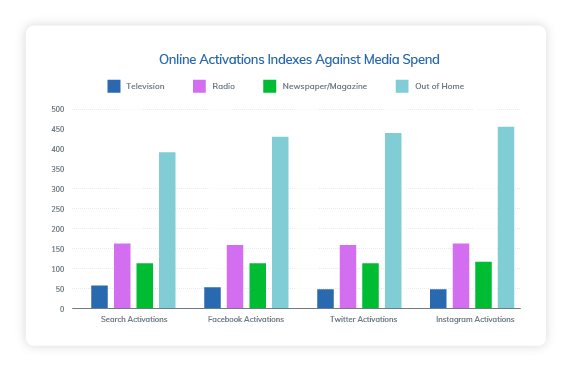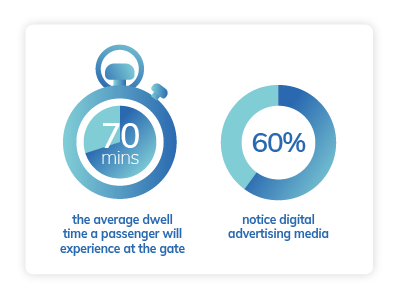The programmatic digital out of home (pDOOH) industry is growing at a rapid pace.
According to a recent eMarketer report, programmatic DOOH will account for 16.4% of total digital out of home (DOOH) ad spending by 2022.

(Data Source: eMarketer)
Programmatic DOOH has become an integral part of the marketing mix for advertisers looking for cost-effective solutions to reach their target audiences on specific outdoor sites using automated and data-driven programmatic ad buying technology.
Below, we explore how pDOOH can be used by SMBs to drive enquiries and leads into their business through various methods, including location targeting, contextual placement, audience targeting, programmatic ad creative and optimization of media investments.
What Is Programmatic DOOH?
First, a quick primer of programmatic DOOH. Programmatic DOOH automates the buying and selling process of digital Out of Home advertising on programmatic platforms such as The Neuron.
Programmatically buying DOOH ads allows advertisers to plan all their media decisions, including creative and messaging, in advance, so that they can automatically execute their campaign over a defined period.
Using pDOOH to Drive Enquiries and Leads
Getting quality leads is about focusing on marketing fundamentals – and marketing automation is now a vital cog in any successful marketing campaign.
Programmatic DOOH uses automation to solve a big headache that advertisers have had to grapple with for decades – how to cost-effectively find and access outdoor media locations that fit their targeted buyer profile.
And as an SMB, budgets are often tight and resource scarce, so you’re looking for ways to save time and drive a cost-effective marketing program where you only pay for the ads that reach your target audience.
If that’s the case, programmatic digital Out of Home is for you and your business.
Here’s what you need to do to start driving leads and enquiries using programmatic DOOH.
1. Identify Your Target Audience
Before you can place your ads on pDOOH platforms, you need to have a specific audience in mind that the programmatic ad will target.
This specific audience should correspond to people who are likely to find your offer appealing, given their profile, location, habits, tastes and preferences. It’s also important to consider how many people are part of this target audience to avoid wasting time or money focusing on an insufficiently sized target market.
You can then use pDOOH technology to target custom audiences on selected DOOH screens in the real world at a granular and behavioral level. Using anonymized location-based data, such as mobile location data, pDOOH platforms build a comprehensive picture of where your target audience is likely to be at any given time.
The platform can then be used to buy ad space and activate DOOH screens wherever significant numbers of your target audience are located, ensuring you reach them with timely and relevant messages that will drive leads to your business.
2. Prepare Your Ad Creative with Thought
Once you identify your target audience, it’s time for creative preparation, which involves thinking about all the information that needs to go into the ad without overwhelming the audience.
In particular, you must have a clear call to action (CTA) that tells your audience what to do after viewing your creative. CTAs should be designed with a clear outcome in mind. This action could be visiting your nearby store, visiting your website, using a promo code to activate a discount for a product or service, following your brand on social media or booking an appointment, etc.
Today, nearly everyone carries a smartphone around in their pocket. Creative DOOH ads with a clear CTA are a fantastic way to entice viewers to look at their phone and trigger mobile interaction with your brand.
In fact, DOOH is hugely powerful for driving online action, helping you generate leads and enquiries across your digital touch points.
According to a Nielsen study, out-of-home dwarfs other offline media in its ability to drive online searches and engagement across Facebook, Twitter and Instagram.

(Image source: oaaa.org)
3. Decide on the Type of Out of Home Venue for Your Ad
This step involves deciding on the best locations to reach your target audience effectively. It’s important to choose sites where your target audience is likely to be. Thankfully, programmatic DOOH allows advertisers to locate relevant audiences easily using geotargeting.
The great thing about buying DOOH programmatically is that you have immediate access to premium DOOH inventory in all types of shapes, sizes, and locations. These include:
- Roadside Outdoor
- Spectacular displays
- Urban panels
- Bus shelters
- Highway billboards
- Roadside billboards
- Transit
- Airports
- Buses
- Taxis
- Subways
- Train stations
- Retail
- Gas stations
- Convenience stores
- Grocery stores
- Liquor stores
- Malls
- Dispensaries
- Pharmacies
- Parking garages
- Place-based
- Gyms
- Salons
- Spas
- Schools, colleges and universities
- Office buildings
- Movie theatres
- Sports and entertainment venues
- Hotels and Bars
- Banks
- Apartment buildings
It’s crucial that the right DOOH screens are utilized to target the right audiences. For instance, little engagement would be generated for a drive-thru restaurant by selecting screens at a liquor store or pharmacy. For such a campaign, roadside and highway billboards would, of course, be much more appropriate and fruitful.
It must also be considered that within certain locations, there are functional differences between individual screen venues.
Take airports, for example. A screen located in the baggage claim area is functionally different to a screen located at the departure gate. The former would be most usefully selected to target consumers upon arrival who are perhaps looking for refreshment, things to do, places to visit, or transportation. The latter, meanwhile, targets passengers waiting for a flight departure – and so may be better utilized by advertisers looking to drive mobile action, as dwell times are high and consumers are looking for a distraction.

(Image source: airportadvertisingmedia.net)
Looking for a Reliable Programmatic DOOH Platform?
At The Neuron, our powerful programmatic DOOH platform simplifies the buying of ad space on digital signage. We power the pDOOH advertising industry with location-based intelligence using a variety of different GDPR-compliant data feeds, meaning you can target the leads at the right and time on the right digital OOH screens.
Our platform is easy to use and you can build and execute your campaign across a range of outdoor displays with immediate access to premium inventory. You can also access real-time metrics and reporting to optimize your strategies immediately.
For more information on using The Neuron to drive enquiries and leads, check out our SMB page.


